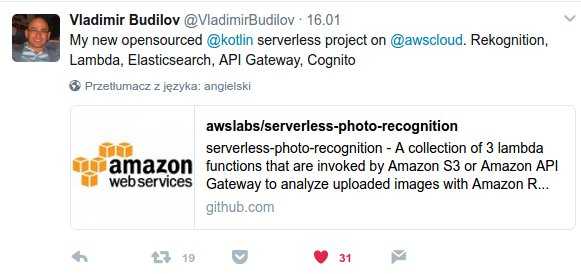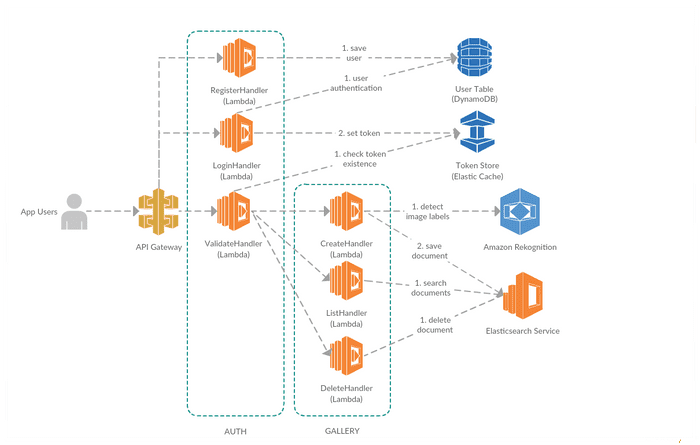Some time ago I came across the following tweet.
There were two things that took my attention - kotlin and Rekognition.
First one is a “new” (it’s relly developed by over 6 years now) JVM language created by JetBrains, company that stands behind great tooling for developers of different professions. The second is an AWS service, this is how it is described on their page
Amazon Rekognition is a service that makes it easy to add image analysis to your applications. With Rekognition, you can detect objects, scenes faces; search and compare faces, and identify inappropriate content in images. Rekognition’s API enables you to quickly add sophisticated deep learning-based visual search and image classification to your applications.
as we will see soon this API is very easy to use.
Why
At this point for me, it was the first contact with pretty nice and interesting example of AWS Lambda usage created by Vladimir Budilov (here is a github repository). For these who are not familiar with AWS Lambda term - it is a new category of cloud computing services called FaaS (function as a service). It stands next to IaaS (infrastructure as a service), PaaS (platform as a service) and SaaS (software as a service) it is also referred as Serverless architecture. In short, you focus only on your business logic and don’t care about provisioning and managing servers.
 Source: Deploy microservice using Amazon Web Services S3, API Gateway, Lambda and Couchbase by Arun Gupta (https://www.youtube.com/watch?v=eT4EaU2mfL0)
Source: Deploy microservice using Amazon Web Services S3, API Gateway, Lambda and Couchbase by Arun Gupta (https://www.youtube.com/watch?v=eT4EaU2mfL0)
After analysing serverless-photo-recognition repository I felt urgent need to write something of my own. One thing that I considered not to be very concise was a setup step. The author created setup script which is very verbose. So let’s start by making this process a lot more easier (to make and understand - for people not so familiar with AWS platform).
Serverless framework
Serverless framework is a cli tool that creates great abstraction over AWS CloudFormation and automates the whole process of setting up cloud infrastructure required by our functions. We start by installing serverless framework
npm install -g serverlessthen a good idea is to create dedicated AWS user that will be used on behalf of serverless framework. Exact instruction of how to accomplish this can be found here. In my case, this user hides behind sless AWS cli profile name - see here. All configuration is placed in one file serverless.yml
where we first define provider
provider:
name: aws
runtime: java8
profiles: sless
timeout: 60
environment:
DYNAMODB_USER_TABLE: ${self:service}-${opt:stage, self:provider.stage}-user
ES_DOMAIN_NAME: es-gallery
REDIS_URL: ${file(serverless-config.yml):${opt:stage, self:provider.stage}.RedisUrl}
REDIS_PORT: ${file(serverless-config.yml):${opt:stage, self:provider.stage}.RedisPort}
ES_URL: ${file(serverless-config.yml):${opt:stage, self:provider.stage}.ElasticsearchUrl}
iamRoleStatements:
- Effect: "Allow"
Action:
- "lambda:InvokeFunction"
Resource: "*"
- Effect: "Allow"
Action:
- "rekognition:DetectLabels"
Resource: "*"
- Effect: "Allow"
Action:
- "es:ESHttpDelete"
- "es:ESHttpGet"
- "es:ESHttpPost"
- "es:ESHttpPut"
Resource: "arn:aws:es:${opt:region, self:provider.region}:*:domain/${self:provider.environment.ES_DOMAIN_NAME}/*"
- Effect: Allow
Action:
- "dynamodb:GetItem"
- "dynamodb:PutItem"
Resource: "arn:aws:dynamodb:${opt:region, self:provider.region}:*:table/${self:provider.environment.DYNAMODB_USER_TABLE}"this is a place where we can configure mentioned AWS cli profile, runtime environment, extend the limit of our functions execution time to 60 sec, define environment variables that will be accessible from within our functions and also we can define a security policy for a lambda role created automatically by serverless. From above snippet, we see that security statements were defined for lambda, elasticsearch, rekognition and dynamodb services, specifying what action we can execute on them.
Lambda in action
I wrote a simple CRD (no update) functions with custom authentication mechanism - probably using AWS Cognito would be a preferred way to go but I wanted to check how flexible are these lambda functions in terms of implementing own authentication. Application architecture is following
I believe that above diagram is self-explanatory so let’s dive into one of the functions. CreateHandler, the entry point is handleRequest function triggered by AWS when an HTTP POST request reaches API Gateway at /gallery path.
override fun handleRequest(input: Request, context: Context): String {
LOG.debug("input(\n$input\n)")
if (input.base64Image == null || (input.base64Image as String).isBlank())
return response(400, "Invalid identify request: no or empty 'base64Image' field supplied")
val imageInBytes = base64ToBytes(input.base64Image!!)
val labels = rekognitionService.imageLabels(imageInBytes)
val galleryItem = createGalleryItem(asciiService, imageInBytes, labels)
val result = esService.add(input.principalId!!, galleryItem)
when(result) {
true -> return galleryItem.id
else -> return response(500, "Failed to save image")
}
}In this function, we validate incoming request to check if base64 encoded image string exists and is not blank. Then encoded image is converted to byte array and passed to Rekognition service. This service is a wrapper around AWS Rekognition service to simplify interaction with it.
fun imageLabels(image: ByteArray): List<String> {
LOG.info("Recognize image labels")
val response = amazonRekognition.detectLabels(DetectLabelsRequest()
.withMaxLabels(10)
.withMinConfidence(60f)
.withImage(Image().withBytes(ByteBuffer.wrap(image))))
return response?.labels?.map { it.name }.orEmpty()
}As mentioned at the beginning, using AWS Rekognition service we were able to define a sophisticated deep learning-based operation of labelling objects present on a given image just in few lines of code.
When using serverless framework we need to create a configuration for each function. Configuration for CreateHandler function is following
create:
handler: ajurasz.lambda.gallery.CreateHandler
events:
- http:
path: gallery
method: post
integration: lambda
request:
passThrough: WHEN_NO_TEMPLATES
template:
image/png: '{ "operation" : "create", "base64Image" : "$input.body", "principalId" : "$context.authorizer.principalId" }'
authorizer:
name: auth
resultTtlInSeconds: 30
identitySource: method.request.header.tokenwe see that this function is triggered by HTTP specific event - POST request to /gallery path. This configuration is little bit more complicated than for other functions and this is because we are not using default lambda-proxy integration (integration between API Gateway and Lambda) as we need to customize it to handle binary data. More information about handling binary data in AWS Lambda can be found here. We also secured our function with auth function that will be invoked before target function to check if supplied token is valid. auth function response is cached for 30 sec, the cache key is a identitySource. Usually when using proxy approach the whole request is forwarded to our function and configuration is as easy as
list:
handler: ajurasz.lambda.gallery.ListHandler
events:
- http:
path: gallery
method: getor
delete:
handler: ajurasz.lambda.gallery.DeleteHandler
events:
- http:
path: gallery/{id}
method: delete
authorizer:
name: auth
resultTtlInSeconds: 30
identitySource: method.request.header.tokenwhen we want to secure our endpoint.
Testing
With good encapsulation, you can test a lot. In my case, I only was not able to test Rekognition and DynamoDB services so had to use mocks. Recently (again, thank you Twitter) I found that allegro tech team open sourced embedded-elasticsearch to make unit and integration testing easier and more reliable.
Deployment
This can obviously be a part of CI/CD pipeline as when everything is ready you need to execute just two commands
./gradlew test
serverless deploythis could be simplified to just one command by executing serverless command from within gradle task.
Conclusion
Personally, I wouldn’t consider building my whole application as functions from one simple reason - vendor locking (this article is kind of “lessons learned” type in terms of vendor locking). But this is a great option when you need to run some simple function triggered by different events somewhere on the web. There is still some lack in case of debugging (or I didn’t yet discover how to do it properly) these functions - at this point I will say only - logger is your friend.

